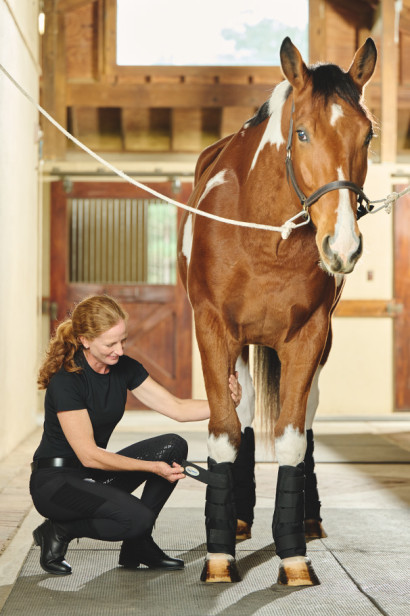Why Equine Therapy is Coming To Be a Preferred Choice for Emotional Wellness
Why Equine Therapy is Coming To Be a Preferred Choice for Emotional Wellness
Blog Article
Reviewing the Effectiveness of Laser Treatment in Horse Therapy for Injury Recovery
The assessment of laser therapy's effectiveness in equine injury rehab hinges on several aspects, including recovery time, pain reduction, and tissue regeneration. Veterinarians frequently observe exceptional results with laser therapy contrasted to traditional approaches, placing it as an essential component in equine care.
Understanding Laser Therapy
Laser treatment has become a pivotal device in vet medication, especially in the therapy of equine conditions. Recognized for its non-invasive nature and efficacy, laser treatment includes the application of certain wavelengths of light to promote cells fixing and minimize swelling. This therapeutic modality is significantly favored for its ability to increase the healing process in steeds enduring from a range of bone and joint injuries and persistent problems.
The main device behind laser therapy is its capacity to improve mobile functions. When laser light permeates the skin, it is absorbed by mitochondria, the powerhouse of cells, which brings about enhanced production of adenosine triphosphate (ATP) This biochemical power boost promotes cellular repair service and regeneration. Additionally, laser treatment advertises vasodilation, enhancing blood circulation and oxygen delivery to broken cells, therefore accelerating healing.
In equine medication, laser therapy is specifically advantageous for problems such as tendonitis, osteo arthritis, and injury healing. The technique is lauded for its pain-relieving residential properties, enabling equines to gain back wheelchair and feature a lot more swiftly. Vets additionally value its marginal side impacts contrasted to various other therapy modalities, making it a dependable and risk-free choice for equine care.

Just How Laser Therapy Works

Upon absorption, these photons activate a collection of biochemical changes, improving mitochondrial function and resulting in raised adenosine triphosphate (ATP) production. This surge in ATP accelerates cellular metabolic process, promoting tissue fixing and regrowth. Furthermore, laser treatment modulates inflammatory responses by impacting cytokine degrees and reducing oxidative anxiety, thus relieving pain and swelling.
Another substantial element of laser treatment is its role in boosting microcirculation. The therapy advertises vasodilation, enhancing blood circulation and oxygen delivery to damaged cells (Equine Therapy). This assists in the elimination of mobile debris and sustains the proliferation of fibroblasts and collagen synthesis, critical for injury healing
Scientific Evidence
The effectiveness of laser therapy in equine treatment has been confirmed through different scientific studies, showcasing its therapeutic possible across an read what he said array of conditions. A study performed by Turner et al. (2012) demonstrated that horses treated with low-level laser therapy (LLLT) for ligament injuries showed sped up recovery compared to those obtaining traditional treatments.
Similarly, study by Johnson and colleagues (2015) concentrated on equine muscle mass injuries, disclosing that laser therapy dramatically accelerated muscle mass fiber regrowth and minimized muscle mass rigidity. Medical evaluations have revealed that laser treatment can reduce persistent conditions such as osteo arthritis.
Vet Insights

Vets likewise appreciate the convenience of laser therapy. It can be used for a large range of conditions, from surface injuries to deeper bone and joint injuries. Dr. Emily Brown highlights its utility in treating conditions like tendonitis and osteoarthritis, where standard therapies often fail. She mentions that laser therapy can be customized to the specific requirements of each steed, guaranteeing optimum end results.
Additionally, veterinarians value the ability to integrate laser therapy with other therapy modalities. This multimodal strategy can enhance total therapy efficacy, giving a thorough option for equine rehabilitation. Such endorsements from experienced specialists underscore go right here the growing approval and application of laser treatment in equine medicine.
Practical Considerations
A crucial element of executing laser treatment in equine treatment includes recognizing the functional considerations that ensure its efficacy and security. It is essential to pick the appropriate laser device, as numerous kinds vary in wavelength, power, and infiltration deepness. Vets should be fluent in these parameters to customize therapy protocols efficiently to each injury type
Additionally, the frequency and duration of laser treatment sessions require cautious planning to optimize restorative benefits while minimizing any kind of possible negative impacts. Constant surveillance of the equine's feedback to treatment can direct necessary adjustments in the treatment routine. Establishing a secure and regulated environment during treatments is additionally important to stop accidental exposure to laser discharges, which could damage both the steed and the trainer.
Training and qualification of employees carrying out laser treatment are vital to guarantee proper method and to promote security requirements. Additionally, maintaining precise records of each session, consisting of laser setups and observed outcomes, is essential for reviewing the total effectiveness of the treatment and for making data-driven decisions.
Final Thought
Laser therapy has actually become an efficient modality in equine injury rehab, supplying significant advantages in recovery time, pain alleviation, and cells recovery. Scientific researches underscore substantial improvements in problems such as tendonitis and osteo arthritis, Website credited to enhanced cellular function and boosted ATP manufacturing. Vet monitorings prove these findings, highlighting superior outcomes compared to conventional treatments. For ideal results, constant monitoring and individualized treatment procedures remain vital in leveraging the complete potential of laser treatment in equine care.
Report this page